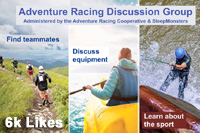Eco-Challenge
A Quick Guide to Eco-Challenge
Rob / 08.10.2002


Eco-Challenge! It’s a name that means so much to so many. It’s the best known adventure race in the world (unless you speak French) and has inspired many to take up adventure racing in the hope that one day they will finish an Eco.
It’s one of the most remarkable sporting events on the planet and effectively a world championship race. Their official press releases tell us this, but it’s a hard case to argue against. Eco-Challenge is more than just a race. It’s an adventure in the most remote and challenging terrain in the world, an expedition requiring exceptional endurance, training and teamwork. For many it’s a once-in-a-lifetime trip and for some a life changing experience.
HistoryIn the early days of AR Gerard Fusil dreamt up the Raid Gauloises and one of those who took part was British adventurer Mark Burnett. He was inspired, saw the potential and started Eco-Challenge with 2 races in Utah and New England in 1995. It quickly caught on in the U.S, (where the majority of teams have always come from) and his promotional flair attracted lots of prime time TV coverage. Soon Eco-Challenge became well known throughout the States and and began attracting the best teams from around the world. So far races have been held in Utah, Maine, British Columbia, Queensland, Morocco, Patagonia, Borneo, and New Zealand.
ControversyMark Burnett quickly became as well known as the race, and the aggressive commercial promotion and multi-million dollar TV deals that have made Eco-Challenge such a huge success don’t always sit comfortably with what some see as the free spirit of adventure racing. Inevitably, success attracts criticism and the race has been accused of being a staged for TV event, paying lip service to the environment, while raking in cash. All lot of people love it, a few hate it. There is no doubt though that it’s helped raise the profile of adventure racing world-wide and is still a race most teams want to do. It fills up within minutes of entries opening despite the high fees. ($14,500 entry fee before you’ve paid for air fares and other costs!)
The CourseThe course is always a combination of biking, paddling, rope work and trekking, with other elements mixed in, some of which are related to the area the race is in. (There has been camel riding in Morocco and Sampan paddling in Borneo in past races.) It’s normally around 300 miles long. Teams are self sufficient, carrying all they need and getting no outside support and the race is continuous, day and night. Naturally, teams never know what lies ahead until the last minute.







 SleepMonsters
SleepMonsters



